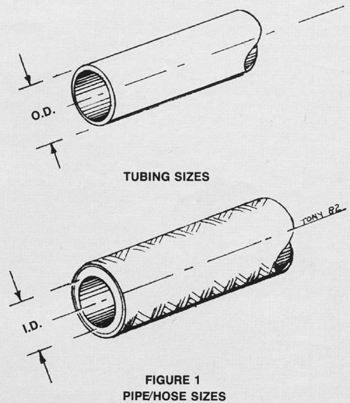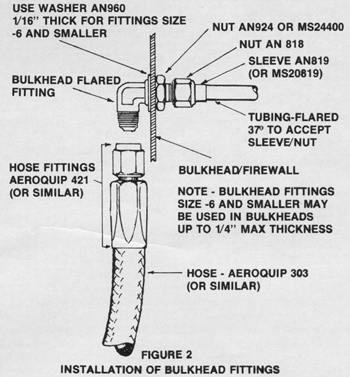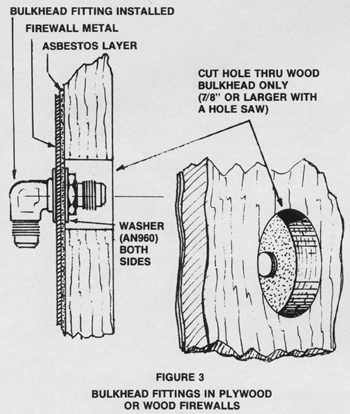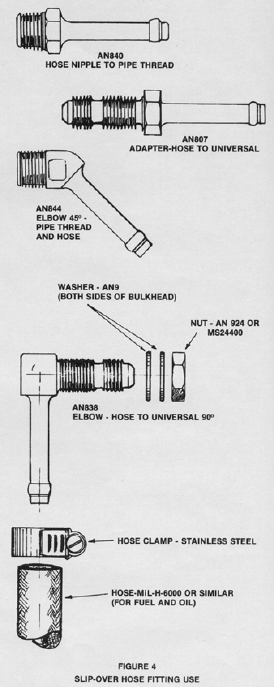Flexible Aircraft Hoses
By Tony Bingelis (originally published in EAA Sport Aviation, July 1982)
MOST OF US wait until our airplane is about completed before we give even a single thought to the hoses and lines that will be needed for completing the aircraft. I suppose, though, that this is inevitable because you really can't tell what size hoses or lengths will be needed beforehand. For one thing there are so many of them . . . the fuel lines, hoses to and from the oil cooler, brake lines, pitot and static lines and, of course, the instrument lines, and if you have a hydraulic system, even more hoses and lines to think about. However, of those mentioned, perhaps the fuel and oil lines (hoses) require our greatest attention.
Aircraft fuel and oil hoses (complete with reusable fittings) are expensive so you can't be expected to purchase a variety of sizes and lengths hoping that you will have some among them that you can use.
It seems to me that the first real decision in this regard is whether to purchase new hoses or to acquire surplus or used hoses.
About Those Surplus and Used Hoses
All sorts of flexible aircraft hoses crop up at used aircraft parts markets around the country and especially at the major fly-ins. It is here that the homebuilder is tempted by the ready availability of "bargains." The "price is right" and sales resistance is at an all time low. Be advised, amigo, that some of those hard-to-find parts displayed in the Country Store or Fly Market are items that the original owner no longer wants, no longer needs, cannot use, wants to get rid of, won't work or are otherwise unusable or worthless (select one). This is also true of flexible aircraft hoses of all types.
Consider for a moment where those hoses might have come from. For the most part, the unused surplus hoses are probably from military sources or from aircraft manufacturer's stores. In either case; the hoses are probably quite old and have exceeded their "authorized shelf life."
A hose `age limit' is generally established to be about four years. The term refers to an arbitrary age limitation established by the manufacturer as the normal storage life for flexible hoses. It does not have anything to do with the life of a hose that is installed and being used in an aircraft, nor is it really an accurate indication of the length of service that could be expected when that hose is installed.
A hose that appears to be new and in excellent condition on visual examination may not be. It may be so old that it has lost its flexibility to a large degree . . . an indication of deterioration.
You will find it difficult to determine the airworthiness of any flexible hose assemblies and especially those having a metal braid lining and/or cover.
A good basic condition check for both surplus and new or used hoses is to flex them to see if they have taken a permanent set. This is not a very scientific means of determining the condition but when hose flexibility is gone, so is much of its useful service life.
If you are still unsure about the condition of the hose, put it close to your ear and flex it. If you hear a crackling sound you can be assured that the hose is indeed becoming brittle and should be discarded.
There is another thing to watch out for in buying surplus hoses. The fittings may be of an odd-ball variety and you could have trouble obtaining matching connectors.
About Buying New Flexible Hoses
I guess we all realize that new hoses and lines ordinarily will provide a better and longer lived installation than one obtained with used or surplus hoses. This is generally true, but, unfortunately, not always. Sometimes even the hoses purchased from an authorized parts outlet may have been sitting on that dealer's shelf for several years. When buying a new hose try to assure yourself that you are not getting one with a high shelf life age. But this may be hard to determine unless it is one of the hoses displaying the manufacturer's markings. Unfortunately, these markings vary considerably. For the most part, the markings on the hose cover display the manufacturer's name, part number, dash number, hose size, SAE number or rating and date of manufacture . . . sometimes, (This information is collectively referred to as the "layline".) Sometimes the layline markings will indicate the quarter year in which the hose was manufactured, thus giving you a clue as to the age of the hose. For example, the marking "4080" means the hose was manufactured in the fourth quarter of 1980. A marking of 2071 would, therefore, imply that the hose has been on the shelf a long time and that it is quite old having been manufactured in the second quarter of 1971.
You may, however, purchase a hose that has no such markings or with unreadable markings so the layline data may not be of too much help. In that case about all you have to go on are the dealer's assurance, the physical appearance of the hose and its flexibility.
Hose Selection
Very obviously a flexible hose suitable for a pitot/static system may be very much unsuited for use as a fuel line, oil or hydraulic line.
Some builders assume that any type of rubberized hose with fittings on both ends would be adequate for their fuel, oil or hydraulic brake system needs just so long as the fittings are the correct size and the hose length is adequate. This is not so. Many light rubberized hoses are intended solely for use in low pressure air and vacuum or instrument lines. These hoses are not, ordinarily, compatible for conveying fuel or oil, nor are they capable of withstanding high temperatures and high pressures.
Hose selection is based on intended use. That is, you will need to know what gas or fluid the hose must carry and under what pressures, the internal and external temperatures to which it will be subjected, and to a degree, the amount of flexing that will be imposed on the hose.
A good all-purpose hose is the Aeroquip 303 hose stocked by most aircraft parts departments, suppliers to the homebuilder trade and automotive speed shops. It is by far the most popular of the flexible hoses being installed in homebuilts. It is a vertical standard hose that can be custom made to, whatever length you need. Best of all you can make up your own hoses easily with the reusable fittings designed for it . . . and at a significant cost saving. The hose has a synthetic-impregnated oil resistant cotton braid outer cover while its inner tube is made of a seamless synthetic rubber reinforced with a synthetic impregnated single wire braid over a layered cotton braid. A hose made like that must be good . . . it is. It is a very tough flexible hose that can be used for operating temperatures ranging from -65°F to 250°F. It also has a maximum operating pressure of 2,000-3,000 psi for the relatively small hose sizes you will be using. This capability also makes it acceptable for your hydraulic system (brakes, gear, etc.) needs.
About Flexible Plastic Hoses, Tubes and Lines
Recently, particularly among builders of composite aircraft, their preoccupation with weight control has led them to the use of lightweight plastic fuel lines. They are installing these lines both ahead of and behind the firewall. Needless to say, plastic lines are far from being fireproof or fire resistant although some types are very well suited for carrying fuel without any detrimental effect. All, however, lack the fire resistant quality of standard aircraft flexible hoses.
Many FAA inspectors look on such installations with disapproval so you better check with your FAA inspector before spending good money on something you may not be allowed to use. It may be that you would still be permitted to use plastic lines inside the engine compartment area if you were to cover them with Firesleeves in a manner satisfactory to your inspector.
Although some types of plastic tubing are very resistant to any detrimental effects from fuel and are relatively long-living, they are best used behind the firewall and not inside the engine compartment. The final word on the subject is yours or, more correctly, the inspectors.
Size Identification For Tubing and Hoses
Tubing and flexible hoses, as well as their fittings, are, identified by dash numbers assigned by the manufacturer. Metal tubing is sized according to its outside diameter (OD) and is measured in 16ths of an inch. A 3/8" (OD) aluminum tube measures 6/16", so the manufacturer uses a -6 as his size identification for all 3/8" tubing and their matching fittings. A -4 size is that assigned to 1/4" tubing (4/16" outside diameter).
Although a flexible hose is bulkier on the outside than its equivalent metal tube, the hose's internal diameter is closely related to the tubing size and its dash number matches that of the metal tube.
Just remember that metal tubing sizes are based on the tube outside diameter (OD) while pipe sizes are measured by their inside diameter (1D).
Hose Installation Details
Locating the proper good quality flexible hoses for your project may be difficult if you live in a small town or city. There is, however, one source you shouldn't overlook. It is the typical automotive speed shop catering to automotive enthusiasts. These auto shops stock and use goodies like 4130 steel tube, rod end bearings and . . . Aeroquip hoses. You can have them make up whatever length hose you need complete with the proper fittings - or you can do it yourself.
If you are making up your own hoses be careful to cut the ends square and clean with a fine tooth hacksaw or the fittings will not seat properly. Cut the hose to the correct length allowing a bit of extra hose for flexing and bending where needed. (Immediately clean the inside of the hose with compressed air.) Heavy aircraft engine oil is O.K. to use as an assembly lubricant. Don't dip the end of the hose into a can of oil - this is a messy, sloppy practice. Instead use an oil can and squirt the oil inside the hose and not all over it. Use a mandrel in mating the fitting to the hose. It will keep the sharp end of the reusable fitting from cutting into the hose wall during assembly and will help keep it squarely aligned. Leave a gap of 1/32" to 1/16" between the nipple hex and the socket when assembling reusable screw-together fittings. Contrary to what one might think, the gap is to prevent torquing the nipple into the socket and imposing an unnecessary stress in the thread relief area of the nipple and not to prevent a cracked socket.
If you will not be installing your hoses for a long time, I would recommend that you coat them internally with lightweight engine oil and plug or cap the open ends. Keep your hoses capped or covered until they are to be installed.
Make your fuel system with as few connections and fittings as possible and secure each line to free it of as much vibration as you can.
Avoid making sharp bends in the hose and route the line so that the fuel will flow uphill or downhill without reversal.
Also avoid twisting the hose when tightening the fittings. A twisted hose subjected to pressure, high temperatures and/or vibration will have a very short useful life.
Not only should all fuel and oil lines inside the engine compartment ordinarily be fire resistant or fireproof, they should be flexible as well. This is because the engine is hung on shock mounts and moves rather freely in them while the firewall and the adjacent aircraft structure areas are rigid and unmoving. Using rigid metal lines (tubing) under such conditions could cause them to harden, crack and fail from continued vibration.
A flexible hose can be made fire resistant or fireproof by slipping a firesleeve (Aeroquip 624) over it and clamping it at each end. The sleeve is a braided asbestos sleeve impregnated and covered with a flame, fuel and oil resistant neoprene substance. The firesleeve may also be helpful in reducing the fuel vaporization tendencies within the line.
Avoid excessive slack (length) in routing the hoses as it results in an unattractive appearance. Route all hoses carefully to keep them clear of sharp edges and moving controls. Also keep the hoses away from hot exhausts and manifolds.
It is important that the fuel line between the gascolator and engine driven fuel pump and/or the carburetor be separated from hot exhaust stacks by a minimum distance of 1-1/4" to prevent heat damage and possibly fuel vaporization.
When connecting the hose fittings be sure the parts are properly aligned. You can assure yourself of this if you can screw the parts together two or three turns with your fingers. If they don't go together that easily, stop. Don't put a wrench to it. You might have a misalignment problem . . . check it out. Another thing, do not try to screw the pipe thread end of a fitting into a flare fitting nut - it won't work.
Finger tight hose connections are as unacceptable as those overtightened. Excessive overtightening is sure to result in a cracked or severely deformed sealing seat in a 37° flare fitting.
Lines that have to pass through the firewall should be connected to bulkhead fittings rather than being forced to pass through a hole in the firewall. This serves two purposes, It eliminates the likelihood that the line will chafe and fail in the firewall area, and it permits a very convenient disconnect point for the system without disturbing the installation on the opposite side.
A wood firewall is quite thick and the bulkhead fittings designed for thin metal firewalls may not have the necessary reach through the wood firewall bulkhead. This, however, is no problem if a large hole about 1" in diameter (use a hole saw) is cut through the wood portion only. A regular (smaller) hole is drilled through the metal part of the firewall and the bulkhead fitting may be installed in the conventional manner. (See Figure 3) This treatment for a wood firewall will allow it to retain the fire barrier integrity of the firewall.
Ask any experienced mechanic. The use of thread lubricant in the assembly of the fuel system components is not necessary. Should you deem it essential to do so, use something like plain of engine oil. Any thread sealant or lubricant used must be applied lightly and only to the threaded male portion of the fitting, Do not allow the lubricant to trail or drip across the end of the fitting.
CAUTION - Do not permit residual fuel from a disconnected hose or line to drip into any part of the aircraft's structure. To do so creates a very serious fire hazard. As you know, fuel fumes are heavier than air and will settle to the lowest areas where even the slightest spark can set oft' the trapped fumes with an explosion or fire.
One final reminder. Installing old or substandard fuel and oil lines in place of good quality hoses is no way to practice economy. A failed hose will surely result in a failed engine or a system, and an unexpected landing which may or may not be totally successful.
Slip-over hose fitting use




